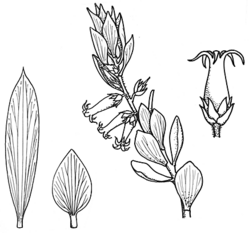Common name: Daphne Heath
Brachyloma daphnoides (Sm.) Benth. APNI* Synonyms: Styphelia daphnoides Sm. APNI*

Description: Erect shrub 40–150 cm high; branchlets hispid.
Leaves ovate or obovate, elliptic or ± circular; 4–15 mm long, 1.7–3.6 mm wide; apex ± obtuse with a small callus; base subobtuse; lamina discolorous, upper surface glossy, lower surface dull and paler, glabrous or hairy; petiole distinct, 0.9–1.2 mm long.
Flowers axillary, often grouped, cream; bracts leafy, caducous, 0.5–2.5 mm long; bracteoles 1–1.7 mm long. Sepals 1.4–2 mm long. Corolla tube usually flask-shaped, 4.3–5.5 mm long; lobes 1.8–2.4 mm long.
Fruit depressed-globose, 2–3 mm long, c. 4 mm diam., ridged, green to yellow-brown.
Flowering: mainly August–December
Distribution and occurrence: Grows in heath, dry sclerophyll forest and woodland on sand, sandy loams or occasionally more clayey soils; common.
NSW subdivisions: NC, CC, SC, NT, CT, ST, NWS, CWS, SWS, NWP
Other Australian states: Qld Vic.
Text by J. M. Powell & R. Makinson
Taxon concept:
| | Key to the subspecies | |
| 1 | Leaves glabrous, 2–19.5 mm, generally >7 mm, long; young stems glabrous or variously hairy; flowers white or with red markings | 2 |
| Leaves scabrous to villous, 1.5–8 mm, generally <7 mm, long; young stems hispid to villous; flowers always white | subsp. pubescens |
| 2 | Flowers white; young stems hispid to villous; leaves 2–19.5 mm long | subsp. daphnoides |
| Flowers with some red colouring, at least at corolla base and lobes when juvenile; stems glabrous to scabrous, rarely sparsely hispid; leaves 2–12 mm long
Back to 1 | subsp. glabrum |
APNI* Provides a link to the Australian Plant Name Index (hosted by the Australian National Botanic Gardens) for comprehensive bibliographic data
***The AVH map option provides a detailed interactive Australia wide distribution map drawn from collections held by all major Australian herbaria participating in the Australian Virtual Herbarium project.
|


